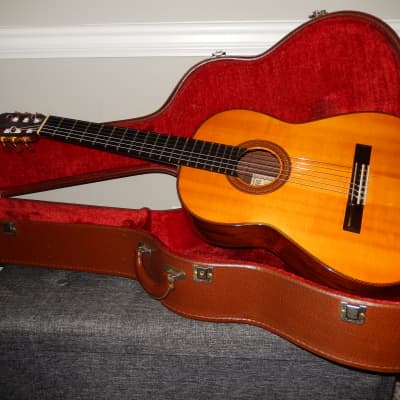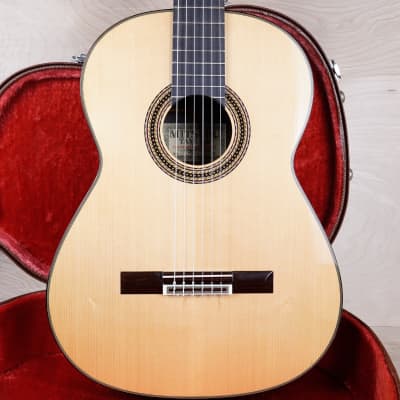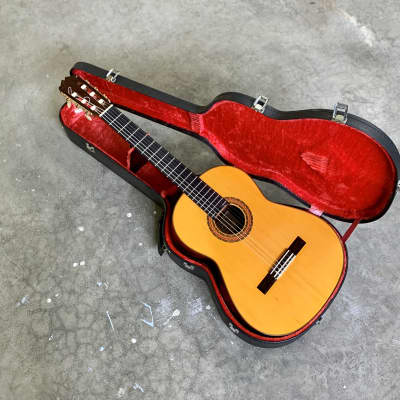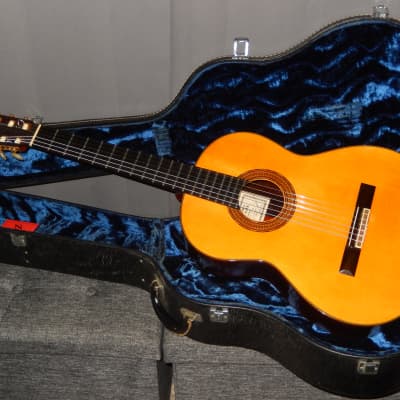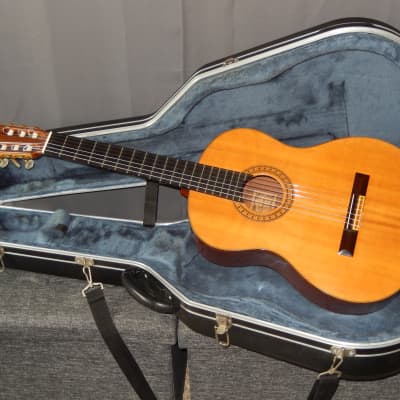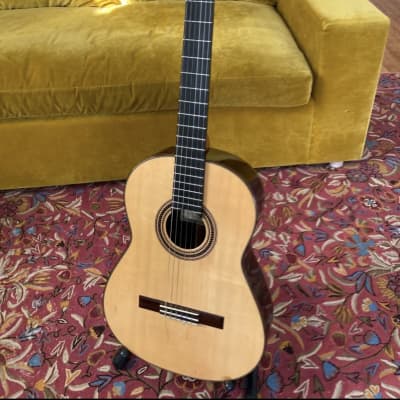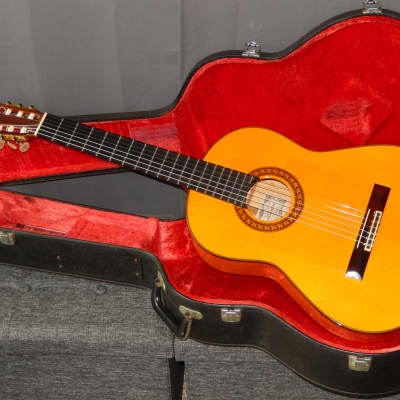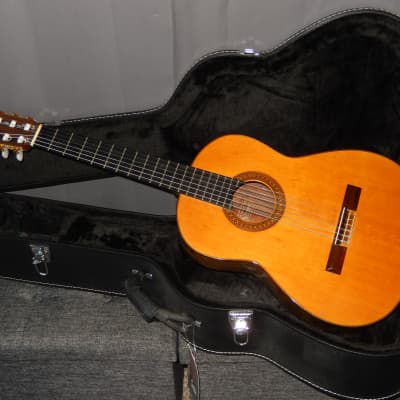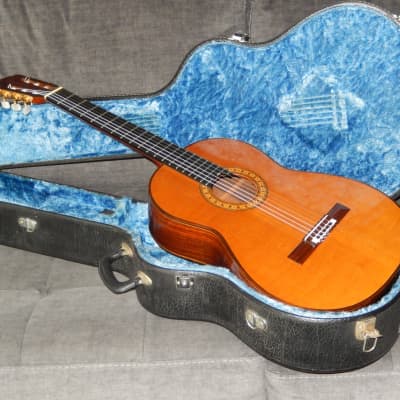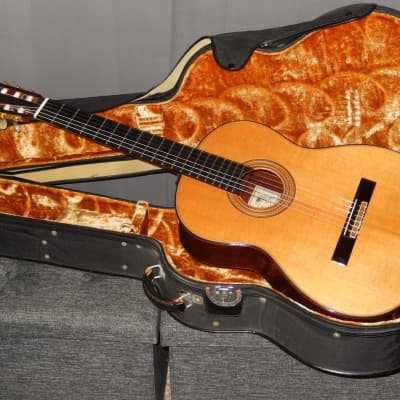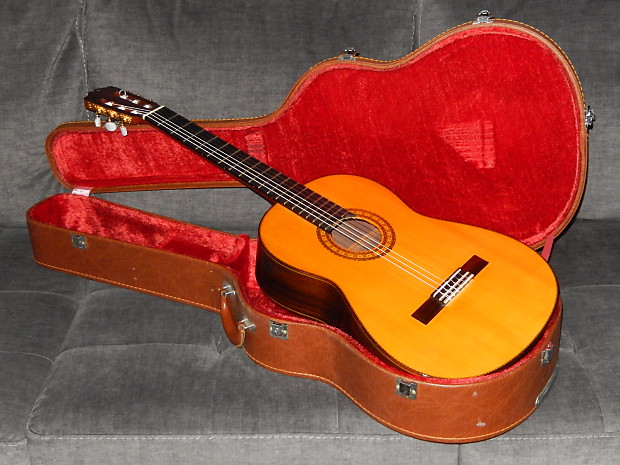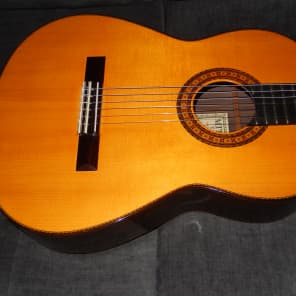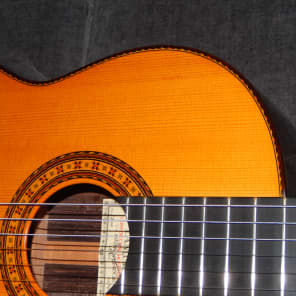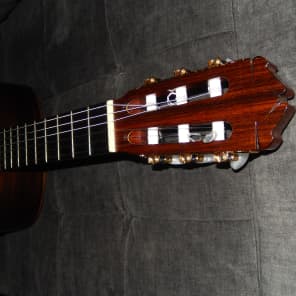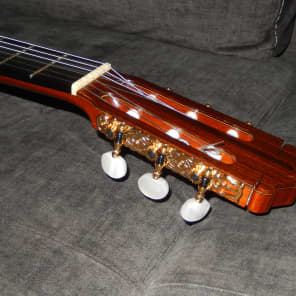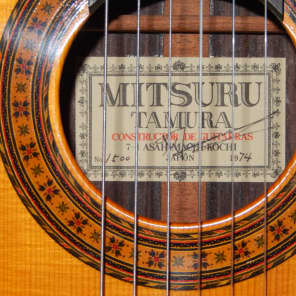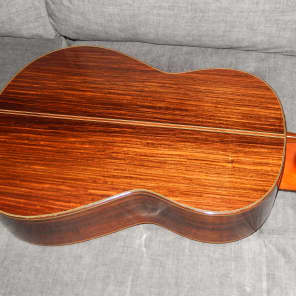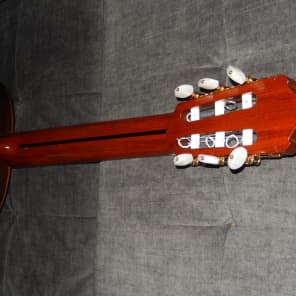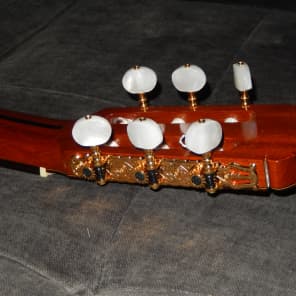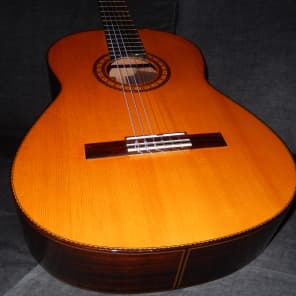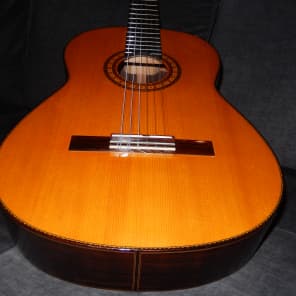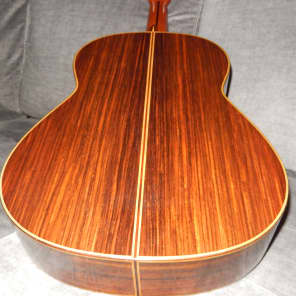MADE IN 1974 MITSURU TAMURA MODEL 1500
This guitar was made in 1974 by Mitsuru Tamura, a brother of better known in the West, Hiroshi Tamura. Both brothers will forever belong to Japanese Elite of Luthiers.
Just like many other famous Japanese luthiers of that era, Hiroshi and Mitsuru Tamura have learned their craft during their stay in Spain in late 1950s/early 1970s. After their return from Spain Tamura brothers were making superb quality flamenco guitars that easily challenged guitars made by the most famous Spanish luthiers. Their flamenco guitars have earned them international recognition and were played by many professional players. Although these are very hard to find, their oldest flamenco guitars were made in 1962. Strangely enough, their oldest classical guitars available on Japanese second hand market were made in 1966.
It is quite possible that, during 1960s, both brothers shared the same workshop located in Kochi, Japan. Although both brothers were equally skilled, it was Hiroshi who has gathered more international and domestic rewards. As the matter of fact, Hiroshi’s rewards outnumbered those collected by Masaru Kohno.
In 1972 Hiroshi was financially rewarded by Japanese Ministry of Technology. Soon after, he moved to another shop, but not far from his brother’s, hired several associates and started to make his P and C models in greater numbers, successfully exporting many them outside Japan. Only the very top models Hiroshi was making by himself.
Mitsuru Tamura has continued to work as individual luthier, and with just couple of apprentices, was making about 15-20 guitars a month. As the result Mitsuru’s guitars are harder to find on Japanese second hand market and their often reach higher prices than guitars made by Hiroshi.
Sometime in 1976, after his “factory” started to produce great financial losses, Hiroshi had to declare bankruptcy and moved back to smaller workshop, making fewer number of guitar with just couple of helpers.
Tamura brothers passed away sometime in 1985. Just like in case of their superb flamenco guitars, their classical guitars are equally regarded in Japan.
This guitar was priced 150 000 yen in 1974 (the same as Kohno #15) while Starting Yearly Salary of Japanese College Graduate was 72 100 yen.
This guitar not only rivals Kohno #15 from that era, but also far more expensive classical guitars made in Spain and everywhere else. It is a rare find and true gem.
It is very important to mention that by the end of 1970s/early 1980s, due to changes in World’s and Japanese economies, as well as new currency exchange rates, guitars made by Japanese luthiers and Gakkis became more and more expensive to international importers. In those years, only few top luthiers and Gakkis (like Masaru Kohno, Sakazo Nakade and Yamaha Co.) having very strong position on international markets, were able to freely raise the prices for their very top luxurious models. Great majority of other Japanese Top luthiers had to price their guitars far more moderately even though they were of the same quality. Strangely enough, until end of their careers (1985) Hiroshi and Mitsuru Tamura’s top models were priced only 300 000 yen, even though they were of very similar grade to Masaru Kohno’s model Maestro or Sakazo Nakade’s model Master 80 (both priced 800 000 yen).
This guitar is very responsive and offers great volume. It produces truly Spanish sound, with deep almost metallic basses, sweet trebles, all well balanced, with exceptional note clarity and separation, and impressive sustain. It can be very well used as “flamenca negra”.
Cosmetically this guitar remains in “excellent condition for its age”. It only has some light scratches and tiny dents within the finish on its top (all visible only from a close distance while flipping the guitar against the light). All other surfaces don’t show any conspicuous “damages’. The only non-original parts on this guitar are the tuners
Specifications:
Top: High Grade Solid Spruce Top/shellac
Back and Sides: Solid Latin America Rosewood/shellac
Neck: Mahogany with Ebony insert
Fingerboard: Ebony
Nut and Saddle: Bone
Nut Width: 52 mm
Scale: 662 mm
Action is set to 3.30 mm under E6 and 2.80 mm under E1, without any extra room on the saddle.
It will be shipped in original used case, that remains it at least very good condition.
Real Value of Japanese Vintage Guitars
The key to understand value of vintage Japanese guitars is to acknowledge galloping devaluation of Japanese yen in 1960s & 1970s. This devaluation was somewhat slower in 1980s. The best measure of this devaluation is Starting Yearly Salary of Japanese College Graduate (SYSJCG).
SYSJCG in 1965 was 19 600 yen, in 1969 – 34 600 yen, in 1970 39 200 yen, in 1972 – 62 300 yen, in 1975 79 200 yen, in 1977 86 200 and in 1980 - 123 000 yen.
During 1960s and most of 1970s model numbers of Japanese guitars were strictly interconnected with their prices in Japanese yen. In late 1970s and during following decades model numbers were no longer strictly associated with their prices. Many Japanese guitar makers introduced model names instead of model numbers. Others were still using model numbers with addition of letter abbreviations or other symbols.
The best and only logical approach while evaluating real value (real grade) of vintage Japanese guitar is to compare its price in Japanese yen with SYSJCG during the year guitar was made.
Any guitar priced 100 000 in 1970 (labelled usually as No10) would be priced 200 000 yen in 1975 (relabeled to No20 or 2000), 300 000 yen in 1977 (labelled as No3, No30 or 3000). Starting in 1977 Masaru Kohno introduced his new models No40 priced 400 000 yen and No50 priced 500 000 yen. By 1984 Kohno started using model names instead numbers and was raising their prices as he was pleased. Model 50 became model “Maestro”, model 40 became model “Special”, model 30 became model “Professional-J”. Naturally other Master luthiers were doing the same name/price changes.
Knowing all of that, you can bet on that Masaru Kohno No50 made in 1982 is practically the same grade instrument as Kohno No20 made in 1972, or Kohno no 30 made in 1976. Kohno No40 made in 1982 is exactly the same grade instruments as Kohno No15 made in 1972 or Kohno No20 made in 1975.
It is very important to mention that if modern era luthiers are using 40 years old woods to make a classical guitar, its price is at least $8000.
Some important info regarding Tamura brothers and their guitars:
Guitarsite.com
Hiroshi Tamura Classical Guitar Model P60 made in Japan by Hiroshi Tamura.
This guitar has a warm, mature voice that plays very easily.
The scale length is 658 mm.
The knut and saddle are made of micarta.
The neck is Honduras Cedar with an Ebony fretboard and Ebony re-enforcing strip.
The top is solid Spruce with beautiful purfling around the soundhole and inlaid banding around the sides and on the back.
The sides are Rosewood veneer, the turners are gold plate.
The neck is straight and there are no cracks or flaws in the guitar but the frets show a small bit of wear.
Please email me with offers. Interested in knowing more about the lutheir too.
Filcker
|
These are very good guitars. I have owned several. a friend of mine was a salesman for the Wilson trading company in Ohio [in the 70's] that imported high end Japanese classical and flamenco guitars.[Tamura,Kohno,Nakati,]
The Tamura guitars won many international guitar building awards in the late 60's. As a previous comment was made, the c series were flamenco [cypress back], the p series were classical [rosewood back]. Many were built to the same spec's and then graded for sound, which determined the price. A p-30 was 300 dollars, a p-50 was 500 dollars. The workmanship is exceptional. I have owned at least 12 of them. I have not had one for several years and have not seen one recently. They are becoming rare. I am still looking for the cypress body ones, preferable a c-60 with wooden tuning pegs [like a violin], I could be interested in all models for the right price. I am happy to pay what would be considered reasonable. I do not believe them to be too expensive, just good. Thanks
|
Tamura brothers were Japanese luthiers living in Kochi-prefecture, Japan. They produced Classical and Flamenco guitars from 1950s to early 1980s. Both of them passed away so there are not many information now. Hiroshi Tamura is older brother and the guitar you have was made by him.
The model on the label can be read "Jupitar" in Japanese language is a flamenco model.
Usually, each model has number which we can know its grade. Classical guitar has "P" but not sure for flamencos. Unfortunately I can't find on your guitar.
For example, P-150 means the price at that time was $1500. P-40 means $400.
Current price for Tamura varies depending on the condition. You can find them through eBay or Japanese auction site or other guitar shops. Sometimes I find $4500 for P-150 and $400 for P-100. Recently I found P-40 for around $500 on eBay.
|
I have a Tamura that I got in 1971, built in 1969, that is a full classical 650 guitar: not a Flemenco guitar. It is one of the finest instruments that I've ever played, and I'll keep it the rest of my life because of it's wonderfully balanced sound. It works very well as a solo instrument, but particularly well in duets and other ensemble situations because of its full mid-range and unusually brighter basses. That's not to say that the trebles are poor: they are snappy and bright if you play them so. Hold this guitar: don't sell. What a gem!
|
I have three Tamura guitars: 1) A 1966 Flamenco with spruce top and Cypress back and sides. I am the original owner purchasing it in 1968 in Okinawa while in the Navy. It has wooden tuning pegs, now changed to a modern type with a better mechanical advantage and it has had a professionally repaired midline crack. 2) a 1970 C-40 Flamenco with cypress back and sides and machine heads. 3) a 1978 P-80 classic in Brazilian rosewood back and sides and I think with an unusual lining of cypress in the interior sides. This was a feature on some of the Ramirez III guitars. None are for sale, as they are in unusually good, nearly mint condition and they have a sound that is at least approaches the sound of some of the best Spanish made guitars. The quality of construction is amazing. I think that if your guitar is without major repair that it is going to be worth over $ 2000 USD. I will eventually post detailed pictures on my site of my three Tamuras as I can see that some will be interested! Take care of that guitar!
Guitarsite .com
The Tamura Bros. are some of the first and finest guitar japan. I have a tamura P30 made in 1968 and signed by H. Tamura, my dad paid about 600.00 back in 1971 and now i have found that the guitar is worth about 3,000.00. it is a beautiful instrument and is made of rosewood. These 2 brothers were possibly the first to build and took much pride in the craftsmanship of the guitars they build. They are no longer with us, but their instruments will be with us a very long time.
Justanunswer.com
Customer
Hiroshi Tamura Classical Guitar
1973 Model P45
Solid Cedar top & solid Rosewood back and sides
Sound v loud and good distinction of notes
Condition v good
All original - including original hard case and hand-made wooden string winder.
Kindly appraise.
Thanks
Expert: replied 622 days and 18 hours ago.
The Tamura brothers (Hiroshi and Mitsuru) lived and worked in Nagoya, Japan, producing superior classical and flamenco guitars from the 1950s to the 1980s. Both brothers are now deceased. Hiroshi Tamura guitars are rare and collectible. If your guitar is in excellent condition, its current retail (replacement) value is approximately $3,000.
Vintageclassicalguitar.com
>
1977 Hiroshi Tamura "P50" Cedar/Indian Rosewood Classical Guitar
Solid Cedar Top
Solid Indian Rosewood Back/Sides with Cypress reinforced sides
Ebony Fingerboard
Lacquer Finish
52mm Nut Width / 658mm Scale Length
Action at the 12th fret (Low E): 3mm
Hiroshi Tamura is known for creating some of the best production guitars to ever come out of Japan, and since the 60s and 70s his guitars have developed a devoted following for their concert sound and high level of craftsmanship and design. The tone is powerful, reminding one of a vintage concert Ramirez with a Japanese touch (the cypress reinforcements are definitely a nod to Ramirez III in that respect). This Tamura is in excellent condition for a guitar of its age, with no cracks or repairs. This guitar does have playing wear and painted fret dots (see photos). Hiroshi Tamura guitars of this quality and condition are becoming rarer and rarer, so don't miss out on adding one to your collection!
Groups.google.com
To the group- please help. I am looking for information on this builder (Hiroshi Tamura). I currently own a 1969 P-50 that is an excellent instrument and I am waiting to take possession of a 1983 P-100 which I
recently purchased. I have been scouring the internet for months in the hopes that I would find something about him (and his brother who apparently had a shop together on Shikoku Island, Jp.) and other than a few web page testimonials, some old internet sales, and 3-4 postings on a Japanese CG web page I have been able to find out little. I am interested to find out his biography; who he trained with (in Spain?); How many instruments did he produce; is he still building,alive?; You know, those sorts of things.Thanks for your help.
Scott Rosette
Hello-
I have been playing a 1968 Tamura P-150 for thirty years and,in my opinion, I've never heard a more sonorus guitar. It also has great projection.But, like you, I haven't been able to find out anything about the maker, Hiroshi Tamura. If anyone knows anything please pass on.
Thanks
Scott
Just to let you know I just got my "new" P-100. Excellente! I don't think it's really ever been played so it still has a little of that closed new guitar sound. (No nicks, marks, fret wear- no nothing except 2 wear marks where it was apparently sitting on a guitar stand for almost a few decades.) Very balbanced sound- no dead spots and it rings! Spruce/Brazillian-nice grain-nothing very dramatic; a little deeper body than my P-50 and, as I was hoping, it has a wider neck at the head nut. Also a much more contempory
shape to the neck- flatter & rounder (the P-50 is more "D" shaped) Seems to have improved his overall building technic although the lacquer is not as good (might be how it was stored & the environment) I'm psyched! 3-4 hours every night after the baby goes to sleep- I might not only open this thing
up , but I may learn how to play it as well.
Scott
Hiroshi Tamura guitars were sold in late 60 & 70 ties at prices between 600 – 1500 USD. These prices absolutely don’t reflect actual value of these guitars, but quite beneficial for US buyers, money market exchange rates at that time. For example the exchange rate between USD and Yen in 1975 was around 300 yen per dollar. With current exchange rates the same guitars would be priced at $1800 - $4,500.00. If these guitars were made in Spain their prices would be 3 times higher. It is also worth to mention, that since spruce tops produce louder and sweeter sound as they age, this guitar being 46 years old is a true gem.

